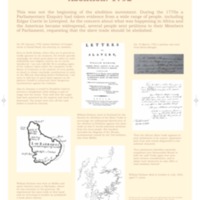
Dumfries and Galloway and the Transatlantic Slave Trade
An exhibition exploring the connections between the Scottish region of Dumfries and Galloway and the transatlantic slave trade toured Dumfries Museum, the Stewartry Museum in Kirkcudbright and Stranraer Museum. At each venue, the exhibition was accompanied by displays of material and a lecture. The catalogue of new research to supplement the exhibition by Frances Wilkins set out to correct misunderstandings about the role of people from the region in the transatlantic slave trade, to prove a history of connections independent of Glasgow or anywhere else. Evidence suggests that men from smaller towns such as Dumfries and Kirkcudbright were involved in the transatlantic slave trade as merchants, slave traders or plantation owners. For example, in the late 18th century, plantation supplies were sent from Kirkcudbright to the island of Grenada; the vessels returned with rum, sugar, and cotton wool.
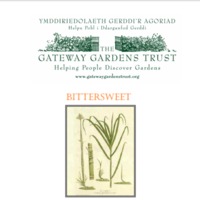
Bittersweet: Sugar, Spice, Tea and Slavery
The Bittersweet programme by the Gateway Gardens Trust involved 80 free guided garden visits over two years, around more than 30 gardens in Wales with a range of community groups, schoolchildren and lifelong learners. The themes of the visits and a mobile exhibition were the links between the slave trade and historic gardens, their makers, what they planted, Welsh abolitionists and the wider links with local communities in Wales. Historic gardens provided the starting point, looking at how everyday vegetables and fruits - beans, potatoes, tomatoes etc. - first reached the UK from the Americas. The project also looked at the history of afternoon tea, and the links between sugar, cotton and tea and slavery. The groups reflected on how many industries, grand houses and gardens were built from wealth linked to slavery, such as Cyfarthfa Ironworks in Merthyr and the expansion of the slate industry at Penrhyn Quarry. Early 18th century-style newspapers were produced, aimed at schoolchildren and adults.
Gardens involved included Cardiff’s Bute Park, Swansea’s Singleton Park, the National Botanic Garden in Carmarthen, Gwydir Castle in Llanrwst, Dyffryn Gardens, Portmeirion, Penrhyn Castle, Picton Castle, Dinefwr Park and Castle and Aberglasney Gardens.
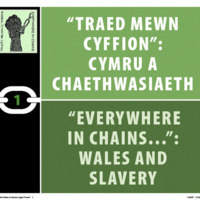
Everywhere in Chains: Wales and Slavery
Everywhere in Chains was an umbrella project created for the bicentenary commemorations in 2007, by a collaboration between Amgueddfa Cymru - National Museum Wales, the National Library of Wales, University of Wales, Bangor and CyMAL: Museum Archives and Libraries Wales (part of the Welsh Assembly Government). An exhibition explored Welsh involvement in slavery, especially focusing on the transatlantic slave trade and its abolition, the Black presence in Wales, and legacies of slavery. This was shown at the National Waterfront Museum in Swansea from May to November 2007 before touring to Wrexham County Borough Museum. The touring version of the exhibition was funded by the Welsh Assembly Government. The exhibition in Wrexham included discussion of the painting 'A Negro Coachboy', thought to commemorate a black servant of John Meller, owner of the Erddig estate in the 18th century.
Alongside the exhibition, the Everywhere in Chains programme also included lectures, formal learning activities and performances. An educational pack was produced by CyMAL and distributed to every school in Wales in 2009-2010. A community project created a forum in which participants from many cultural backgrounds could voice their ideas about enslavement. The Everywhere in Chains Community Heritage Toolkit captured the learning from this project. The toolkit, launched in 2009, was produced to help individuals, groups and organisations to work with culture and heritage providers to undertake projects focused on the role of Wales in the transatlantic slave trade and issues of modern slavery.
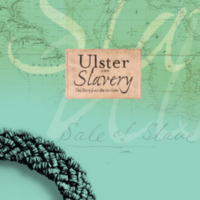
Hidden Connections: Ulster and Slavery 1807-2007
The Hidden Connections exhibition was a result of partnership between the Public Record Office of Northern Ireland (PRONI) and the Linen Hall Library in Belfast. The exhibition explored Ulster's links with slavery after 1807 via people, events and places, and looked at both the pro and anti-slavery debates in Northern Ireland. It drew on documents from PRONI’s archives, artefacts from the Ulster Museum and contemporary books and pamphlets from the Linen Hall Library and elsewhere. After its launch at Linen Hall Library, the exhibition toured Northern Ireland, travelling to Down Museum, the Harbour Museum in Derry, Lisburn City Library and the Ulster American Folk Park.
The wider Hidden Connections programme featured workshops exploring archival sources, performances and lectures by leading scholars. There was a panel discussion on ‘Slavery Now’, a walking tour of Belfast sites associated with the slavery issue, and a boat trip on the Lagan focusing on the port’s links with slave colonies. Gerry McLaughlin’s ‘Blood sugar’ is a drama documentary devoted to the literature of slavery, music and song. 'Freedom and Liberty' was the theme of the UK-wide Archives Awareness Event. PRONI organised special events and produced a catalogue, 'Ulster and Slavery', listing the references to slavery to be found in the archive.
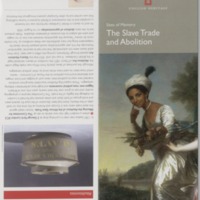
Sites of Memory: The Slave Trade and Abolition
The Sites of Memory project was the first research by English Heritage (now Historic England) to provide an overview for the public of the buildings, memorials and grave sites across England that reflects the role of the slave trade in British history, and resistance to it. The project explored the history of Black people in Britain during the 18th and 19th centuries by exploring the stories behind the historic built environment of local streets, buildings and landmarks. The research (by historians Angelina Osborne and S. I. Martin, on behalf of English Heritage) also identified sites associated with the slave trade and plantation wealth, and with the abolitionists who campaigned for an end to slavery. English Heritage also made recommendations for new listings for historic sites that mark the Black presence.
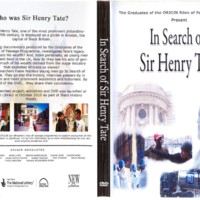
In Search of Henry Tate
A bust of Sir Henry Tate, one of the most prominent philanthropists of the 19th century, is displayed on a plinth in Brixton. A group of young men from the ORIGIN Rites of Passage Programme produced a documentary to investigate Tate's legacy and, in particular, the tensions inherent in his acts of generosity being funded by wealth derived from sugar production. The documentary featured interviews, research, and trips to Tate & Lyle plants and buildings. New Initiatives, a youth and community association, developed ORIGIN as an Africentric rites of passage programme, to support young men of African descent in their transition to adulthood. The project, exhibition and DVD was launched at Brixton Tate Library in October 2010.
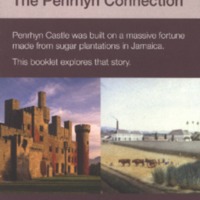
Sugar and Slavery - The Penrhyn Connection
Penrhyn Castle on the outskirts of Bangor in Wales is owned by the National Trust. In 2007, the bicentenary was marked with a special exhibition and accompanying events exploring the connections between the Castle and the fortune of its former owners, the Pennant family, built on Jamaican sugar from one of the largest estates on the island. The exhibition featured the story of Richard Pennant, 1st Lord Penrhyn, a wealthy merchant and MP for Liverpool who fought against abolition in Parliament. Some of the research was carried out by members of the local community, who were trained in archival research by exploring the Penrhyn Jamaica papers held at Bangor University, which included Richard Pennant's letters as absentee landowner.
The project created links between a local school near the Castle, Banks Road school in Liverpool and Mavisville school in Kingston, Jamaica. All three schools provided art, prose and poetry to the exhibition. Workshops were held for all visiting schools. Accompanying events included art days where a local artist worked with visitors to explore the meaning of landscape painting in the context of slavery; a Caribbean weekend; and a day of activities and workshops with a multi-faith groups of teenagers from Liverpool. A DVD of all the information gathered was given free to schools and libraries.
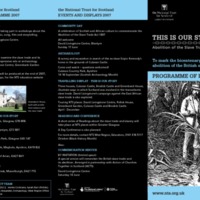
This is Our Story
To mark the bicentenary, the National Trust for Scotland put together a wide-ranging programme of events to engage their audiences with Scottish connections to slavery and abolition. Three National Trust for Scotland properties in the West of Scotland – Culzean Castle, Brodrick Castle and Greenbank House – illustrate the ways in which Scotland was involved in the transatlantic slave trade. A touring exhibition based on this new research was shown at these sites and others in the West of Scotland. The Beckford Collection of furniture, silver and China at Brodrick Castle, on the Isle of Arran, once belonged to William Beckford, owner of several sugar plantations in the West Indies. Scipio Kennedy from ‘Guinea’ lived at Culzean Castle, Ayrshire, from 1710, first as a slave and then as a paid servant. The Allason brothers of Greenbank House were traders in tobacco and slaves. David Livingstone spent much of his life campaigning against the slave trade based in East Africa. His work is remembered at the David Livingstone Centre in Blantyre.
The 2007 Learning Programme involved workshops for local community groups and a resource pack for teachers and youth leaders. Events included a celebration of Scottish and African culture at the David Livingstone Centre; a survey and excavation in search of the ex-slave Scipio Kennedy’s home in the grounds of Culzean Castle; and a Commemoration Service arranged in partnership with Action of Churches Together in Scotland (ACTS).
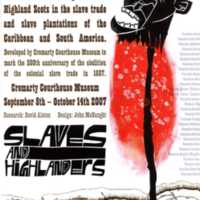
Slaves and Highlanders
An exhibition developed by Cromarty Courthouse Museum in the Scottish Highlands recording the role of Highland Scots in the slave trade and slave plantations of the Caribbean and South America and, in particular, British Guiana. The striking illustrations were by John McNaught. The exhibition told individual stories of Scottish merchants, plantation owners and their slaves, such as a slave called Inverness, bought, sold, exploited and hunted as a runaway by Scots in Demerara. It also looked at the freed slaves who found a place in Scottish society. Connected to this project was the placing of a plaque in the former Royal Northern Infirmary (now the executive office of the University of the Highlands and Islands). It remains one of the few acknowledgements of the use of profits from the slave plantations to fund charitable public institutions, and the only known one in Gaelic.
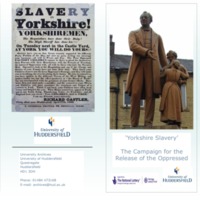
Yorkshire Slavery
Leeds-born businessman Richard Oastler was a leading figure in the 19th century campaign to end child slavery in the factories and mills of Yorkshire. The University of Huddersfield Archives, West Yorkshire Archives, Huddersfield Local History Library and Kirklees Museums and Galleries hold significant sources relating to the Huddersfield centred campaign against 'Yorkshire Slavery'. This project devised an exhibition ('The Past and Present of the Slave Trade') and heritage trail, and ran workshops for school children, local societies and youth theatres. A conference was held, and the University of Huddersfield Press later published John A. Hargreaves and E. A. Hilary Haigh, 'Slavery in Yorkshire: Richard Oastler and the campaign against child labour in the Industrial Revolution' (2012).
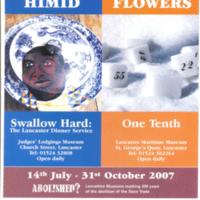
Abolished? Lancashire Museums marking 200 years of the abolition of the Slave Trade
Lancaster was the UK's fourth largest slaving port at the height of the transatlantic slave trade in the 18th century. Lancashire Museums worked with a range of partners to raise awareness of this largely hidden history - first from 2002 through STAMP (the Slave Trade Arts Memorial Project), and in 2007 through Abolished? This bicentenary project consisted of exhibitions, creative writing, radio broadcasts, and schools projects, one of which produced a Slavery Town Trail that explored some of the buildings made possible by the wealth the slave trade brought to Lancaster. At the heart of the project were commissioned installations and interventions by artists Lubaina Himid ('Swallow Hard: The Lancaster Dinner Service' at the Judge's Lodgings) and Sue Flowers ('One Tenth' at Lancaster Maritime Museum). Both were accompanied by outreach programmes and workshops with local schools. A touring exhibition was produced in partnership with Anti-Slavery International and Lancashire County Council Youth and Community, which looked at transatlantic slavery and modern day slavery. The exhibition toured throughout Lancashire.
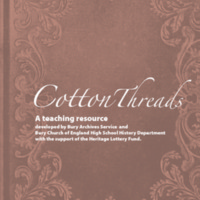
Cotton Threads
Bury Archives and Museum collaborated on an exhibition based on the journals, letters and other papers of John Hutchinson. The Hutchinson family's cotton spinning business had links to slavery in the United States: in 1848, John Hutchinson travelled to America to buy cotton produced by slaves. The exhibition at Bury Art Gallery featured archives, museum objects and paintings that put the papers into a social context. Cotton Threads went on tour to branch libraries, where talks and family workshops explored family histories and the cotton business. Volunteers assisted in conserving, cataloguing and digitising the Hutchinson papers, which were made available online. Primary school pupils took part in workshops held in the exhibition and a resource pack for secondary schools was produced with local teachers (available to download from the Cotton Threads website).
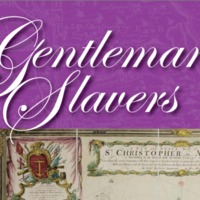
Gentlemen Slavers
Gentlemen Slavers was a project to explore the connections between the transatlantic slave trade and the London Borough of Sutton, particularly through the activities of one family – the Taylors of St Kitts. George Taylor, and later his brother John, lived on the Carshalton Park estate, funded by a family fortune made on slave-worked sugar plantations on the islands of St Kitts and Nevis. The project also looked in detail at the story of Samuel Mudian, a black man who worked at Carshalton Park as a butler for George Taylor, and likely a native of St Kitts. The project consisted of an exhibition, booklet, education pack and activity sheets.
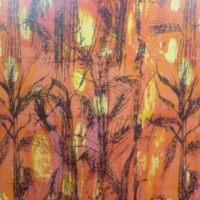
Trade and Empire: Remembering Slavery
The Whitworth Art Gallery was one of eight heritage bodies in the ‘Revealing Histories: Remembering Slavery’ partnership in Greater Manchester. The project set out to explore the history, impact and legacy of slavery on Britain through collections and community links in the North West.
'Trade and Empire: Remembering Slavery' explored the themes of trade and empire, commerce and collecting, and the impact of the experience of slavery and its legacy. Four invited artists and academics (SuAndi, Kevin Dalton-Johnson, Dr Emma Poulter and Dr Alan Rice) worked with Whitworth curators and learning staff to create the exhibition. It comprised of selections from the Whitworth's collections, contemporary works by Black artists, and objects on loan from Manchester Museum, John Rylands University Library Manchester, Bolton Museums and Archives Service and private collections. Areas of focus included a history of the Benin Bronzes, representations of Black people in British art, photographs of West Africa belonging to Tom Singleton Gardner, and printed textiles designed by Althea McNish. The exhibition was accompanied by a series of community engagement events.
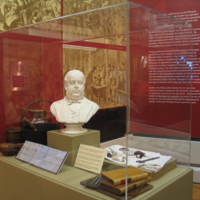
Revealing Histories: Remembering Slavery (Touchstones Rochdale)
Touchstones Rochdale was one of eight heritage bodies in the ‘Revealing Histories: Remembering Slavery’ partnership in Greater Manchester. The project set out to explore the history, impact and legacy of slavery on Britain through collections and community links in the North West.
Rochdale's connections to slavery were explored though two exhibitions at Touchstones Rochdale, which featured museum trails and family events. 'The Fight to End Slavery: A Local Story' examined the town's role in the struggle to end slavery in North America, including the work of prominent abolitionists from Lancashire. The exhibition also looked at the impact of the Lancashire cotton famine, which occurred as a result of the blockade of southern American ports during the Civil War. 'Linking Threads: Textile Industrialists and the Art Collection' focused on works given to the Rochdale Art Gallery collection by benefactors who had links to the local textile industry, such as Robert Taylor Heape and Richard Heape.
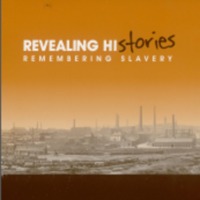
Revealing Histories: Remembering Slavery (Gallery Oldham)
Gallery Oldham was one of eight heritage bodies in the ‘Revealing Histories: Remembering Slavery’ partnership in Greater Manchester. The project set out to explore the history, impact and legacy of slavery on Britain through collections and community links in the North West.
A number of objects from Gallery Oldham's collections were identified as having links to the histories of the slave trade and slavery, focused on the themes of sugar, abolition, the American Civil War and the cotton industry. Two exhibitions also played a role in this trail. 'Cops and Bobbins', exploring Oldham's textile industry, illuminated the links with American slavery in the 19th century. 'Oldham Votes' looked at the significance of the election of 1832, during which slavery and abolition were debated. In collaboration with Touchstones Rochdale, Gallery Oldham also hosted a special day event, 'Slavery - what's it got to do with us?', featuring family activities, debate, and performances of African dance.
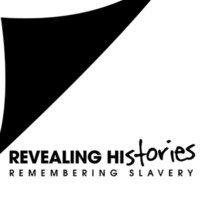
Revealing Histories: Remembering Slavery
The Revealing Histories: Remembering Slavery project sought to uncover the North West's involvement in the slave trade (and the consequent social and economic effects of this involvement) and the region's contribution to the abolition of the transatlantic slave trade and colonial slavery. Eight museums and galleries across Greater Manchester collaborated to commemorate the lasting legacies of the transatlantic slave trade. The participating venues were: Bolton Museum and Archive Service; Gallery Oldham; Manchester Art Gallery; The Manchester Museum; Museum of Science and Industry; People's History Museum; Touchstones Rochdale; and Whitworth Art Gallery. A collaborative website and a programme of exhibitions, trails, performances, films and events took a new look at the collections of these museums and galleries and the buildings in which they are housed, revealing hidden histories of the region's involvement in the slave trade. The project also examined slavery's contemporary legacy and relevance.

Revealing Histories: Remembering Slavery (Bolton Museum and Archives)
Bolton Museum and Archives was one of eight heritage bodies in the 'Revealing Histories: Remembering Slavery’ partnership in Greater Manchester. The project set out to explore the history, impact and legacy of slavery on Britain through collections and community links in the North West.
Bolton Museum and Archive Service launched a trail around its galleries to re-interpret objects on display in the context of slavery and its legacies. At the centre of the trail was Samuel Crompton's spinning mule, a machine which helped to revolutionize the British cotton industry. As part of the project, Bolton Council republished and distributed 'The Narrative of the Life of James Watkins', originally published in 1852. Watkins escaped slavery in the southern United States and travelled to Lancashire to become an anti-slavery campaigner. The museum also hosted African folk storytelling sessions, and produced a Key Stage 3 education pack, 'Chains and Cotton: Bolton’s Perspective on the Slave Trade'. A special event day, 'Facing up to the past' featured performances, poetry reading and debate.
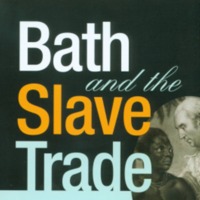
Bath and the Slave Trade
Bath Preservation Trust curated a series of exhibitions across five of their sites, with a focus on ‘unlocking the legacies of the slave trade'. Beckford’s Tower & Museum hosted Big Spenders: The Beckfords and Slavery; displays here and at the Holburne Museum were designed to explore the Beckford family connections to plantations in Jamaica, through objects, paintings and furniture. The Herschel Museum's Slaves to Fashion exhibition, and Number 1 Royal Crescent's Elegance and Exploitation trail looked at how involvement with the slave trade enhanced the luxury of 18th century life in Bath. At the Building of Bath Museum, Selina’s Web revealed the complex attitudes of Selina, Countess of Huntingdon, who sought to promote the publications of free slaves whilst also being a slave owner. A lecture series ran alongside these exhibitions.
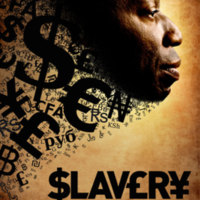
Slavery Not A Thing of the Past
Antislavery International commissioned poster. By foregrounding international currency symbols the image draws attention to the relationship between slavery and capitalism.